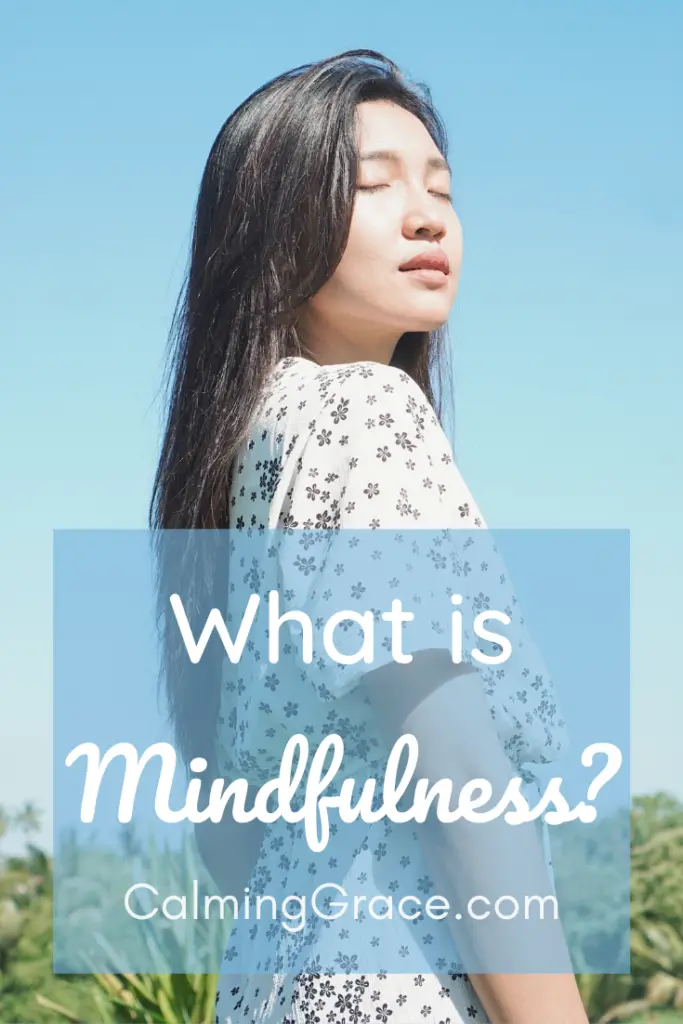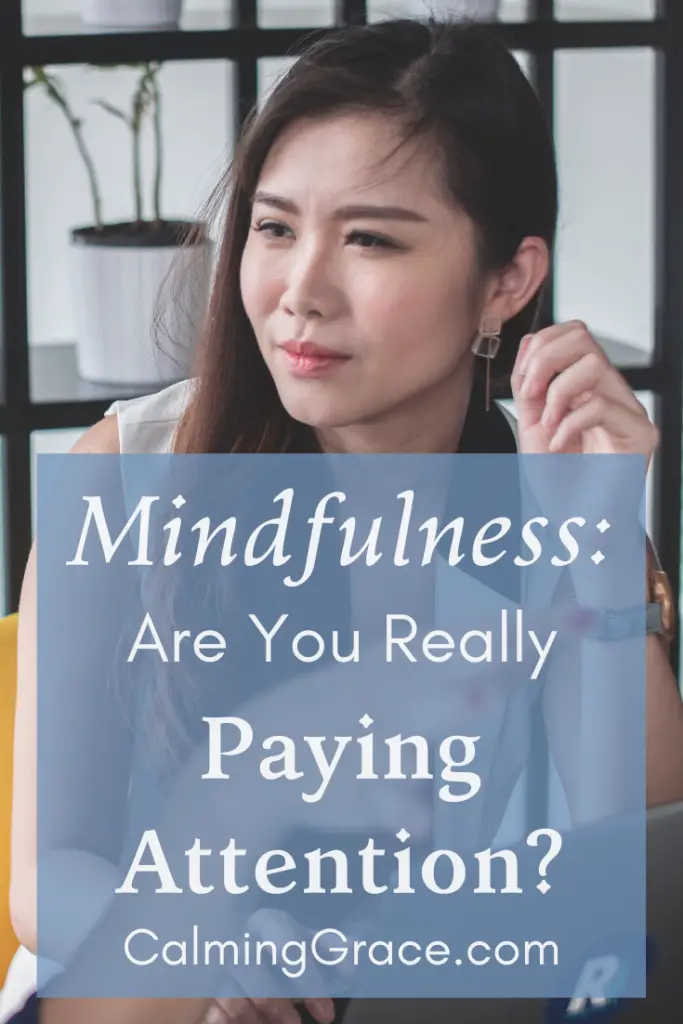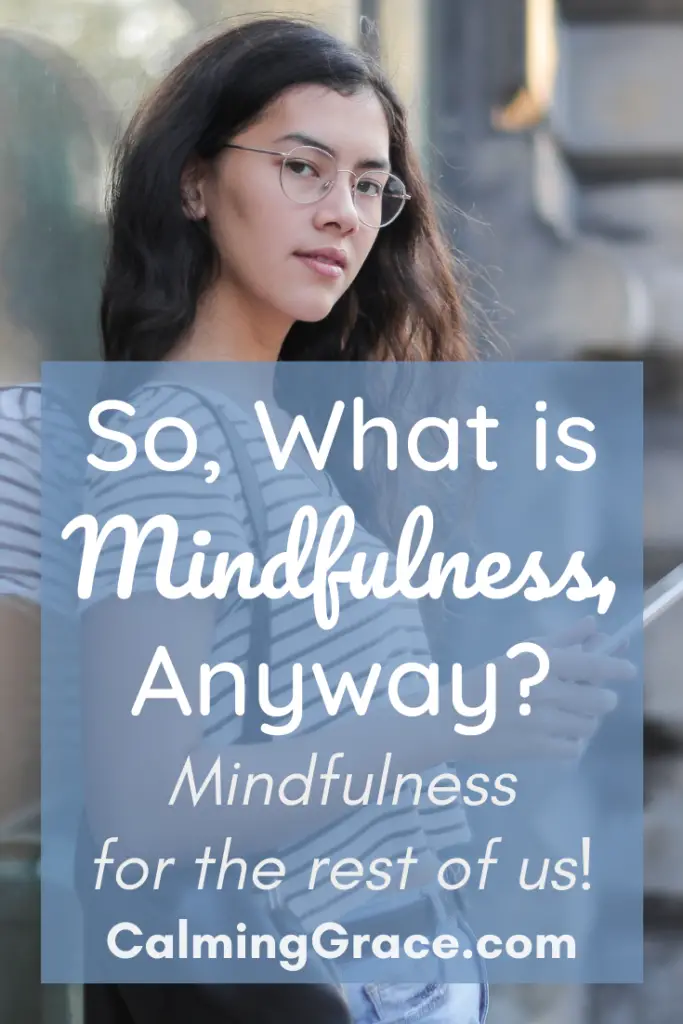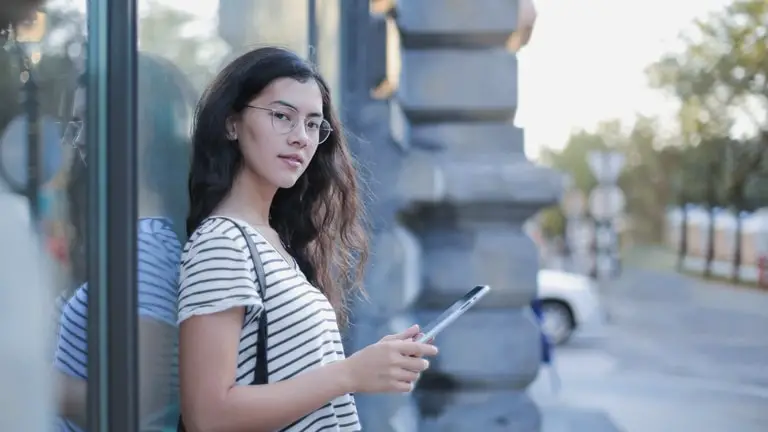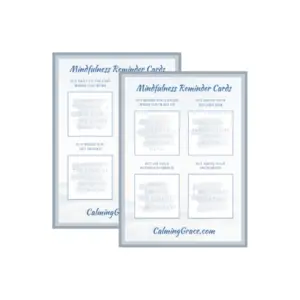Last Updated: September 4, 2024
So, what exactly is mindfulness, anyway?
There’s a lot of hype around mindfulness and an ever-increasing number of research studies on the benefits of mindfulness for mental health and wellbeing (Source). We see it in the news and hear about meditation apps for our phones.
If you’re unfamiliar with what mindfulness is, it might sound like a fad. That’s what I thought, until I gave it a chance and realized that it actually addressed a very real problem I struggled with: the problem of having a stressed, busy mind.
So, in this article we’ll look at what mindfulness really is, and how it can help to quiet and calm our busy minds.
Mindfulness is simply paying attention. A widely circulated definition from Jon Kabat-Zinn is this: “Mindfulness is the awareness that arises from paying attention on purpose, in the present moment, and nonjudgmentally.” (Source: Video/Transcript)
Let’s break down this definition of mindfulness in a clear and practical way.
Contents
- Going Through the Motions or Truly Paying Attention?
- Paying Attention:
- Meditation: Exercising the Attention Muscle
- Things You Can Meditate On Mindfully
This article contains affiliate links. As an Amazon Associate I earn from qualifying purchases. If you buy something using the links, I may earn a commission at no extra cost to you. Read the full affiliate disclosure.
Going Through the Motions or Truly Paying Attention?
When I first heard about mindfulness, I thought to myself, “I guess I’m just naturally a mindful person. I’m always aware of the present.” Not so! I learned later, when I realized I had a tendency to dwell on stressed and anxious thoughts.
You might think you have a “naturally” mindful mindset. But if you look a bit deeper, you might be confronted with how distracted your own mind is: your thoughts wander when you’re working on something; you get stressed thinking about the future; you get upset at yourself when you make a mistake.
Those are symptoms of what most of us are actually used to, which is mindlessness.
Life on Autopilot
Mindlessness is when you’re just going through the motions and doing routine things automatically. The contrast between mindless and mindful behavior was explored widely by Dr. Ellen Langer in her book Mindfulness.

Have you ever cooked a meal, and when it was time to sit down and eat, wondered how that food got on that plate? Thinking back, you realize you just went through all those well-practiced motions of cooking without really considering what you were doing. Your mind was somewhere else entirely, thinking about your to-do list for the next day. You weren’t truly in the present moment.
Researchers call this the default mode of the brain. (See this video in Monash University’s FutureLearn Mindfulness course). It’s the place your mind goes when you’re doing something you’ve done countless times before, and don’t need to think about anymore: washing dishes, driving, taking a shower, folding laundry. When we’re doing these repetitive tasks, our minds wander and think about other things. We’re operating on autopilot.
One Thing at a Time
Mindfulness, on the other hand, means that your mind is focused on what you’re doing in the present moment.

Take washing dishes, for example: you notice the temperature of the water on your hands, the smell of the soap, the texture of the dish and the sponge. You are paying attention to your experience in the present moment, not letting your mind wander on default. Interestingly, this study showed that washing dishes mindfully can help people feel more calm and less stressed.
This doesn’t necessarily mean that the default mode is bad. Allowing our minds to wander can help us to process our experiences, be creative, and think of new ideas. That’s why we sometimes get our best ideas in the shower!
But, if we’re not paying attention to our own actions in the present, then our thoughts can carry us away, ruminating on worry, stress, or negative feelings. The point of mindfulness is to be aware of the present moment, paying attention to what we’re doing now, on purpose.
Read More: 65 Bible Verses About Mindfulness: Attention and Focus
Paying Attention On Purpose
Let’s go back to Jon Kabat-Zinn’s definition, and break it down into three aspects: “Mindfulness is paying attention on purpose, in the present moment, and nonjudgmentally.”
What does it mean to pay attention on purpose?
Our attention is like a laser pointer. It can only be focused on one thing at a time. And we have the capacity to consciously choose where we focus our attention.
Take, for example, all those times when you’ve been looking at your phone and trying to listen to someone talking at the same time. Maybe you’re scrolling through Facebook, thinking that it doesn’t really take that much attention. So you think you can listen to your roommate or family member across the room at the same time.
But then, he or she stops talking, waiting for a response from you, and you suddenly realize that you have no idea what he or she said. “Uh, sorry. What was that?” You put down your phone and listen. Then, when you look at your phone again later, you realize you don’t really know what you were reading.
That’s because it’s impossible to truly pay attention to two things at once. Sure, we all say we can multitask. We can drive and talk on the phone at the same time. But what happens when you’re driving and need to really focus on something, like changing lanes in heavy traffic? You probably lose track of what your friend is saying on the phone, and have to ask them to repeat it. That’s because you had to switch your attention to something else.

Trying to multitask makes us less efficient at whatever multiple tasks we’re trying to do at the same time. Doing things mindfully means that we focus on one thing at a time, on purpose—we consciously decide we are going to pay attention to that one thing.
Want an easy way to practice this? The next time you’re scrolling through your phone and your housemate says something to you, choose to pay attention to them, and put down your phone!
Paying Attention in the Present Moment
The second part of Kabat-Zinn’s definition is paying attention in the present moment.
It’s so easy to dwell on thoughts about the past or the future. We might relive memories from the past over and over, letting ourselves re-experience the discomfort of the situation. For example, I have a tendency to replay conversations in my head when I said something socially awkward, and to feel the awkwardness of the situation all over again. If I don’t catch myself in the middle of the replay, and bring myself back to the present, it can cause me a lot of anxiety!
The question is, what are we doing in the present while our minds are full of anxiety about the past or worry about the future? Whatever we’re doing, we’re probably doing it absentmindedly. We’re just going through the motions, as I mentioned above. The goal of mindfulness, then, is to be present-minded, rather than absent-minded (Source).

When you realize that you’ve let your mind drift off to the past or the future, it’s not that hard to come back to the present. You simply need to bring your attention to what your senses are telling you in the present moment. What can you see and hear? What can you smell, touch, or taste? Are you still breathing?
Our senses provide an anchor to the present moment that we can always come back to, whenever we need to. That’s why the breath is commonly used as an anchor: we can feel ourselves breathing, and we can focus our attention on it in the present moment.
However, although bringing our attention back to the present isn’t difficult, what is difficult is noticing when we’re getting carried away by thoughts about the past or the future. To improve our ability to notice, we have to practice, and one way to practice is through meditation. More on that below.
Paying Attention Nonjudgmentally
The final part of the definition is paying attention nonjudgmentally.
Being nonjudgmental doesn’t mean that you don’t have any opinions. We make judgments all the time as our minds make meaning out of things: These tacos are delicious. This movie is getting boring. What my friend just said—that was a bit sarcastic…
But nonjudgmental awareness, in mindfulness, is simply being aware of these thoughts without judging yourself for them. “It’s more that you don’t judge how judgmental you are,” Jon Kabat-Zinn said in this interview.

We often judge ourselves all the time without realizing it. “I shouldn’t feel disappointed. I just need to get over it.” “I should have done this two days ago.” “I shouldn’t have said that.”
Even when trying to pay attention mindfully, we can get down on ourselves: “Why do I keep thinking about what happened yesterday? I should be focusing on the present.” But these expectations of ourselves are counterproductive, because they make us feel anxious, as we are more aware of what we “should” be doing than aware of the present moment.
Paying attention nonjudgmentally means suspending these judgments, and allowing things to be just as they are. It means eliminating should and shouldn’t from our vocabulary and just accepting what is. It means being gentle and kind with ourselves instead of beating ourselves up over what we think we “should” be doing or feeling.
Read More: 30 Self-Compassion Journal Prompts
Mindfulness Meditation: Exercising the Attention Muscle
So, mindfulness means paying attention on purpose, in the present moment, and nonjudgmentally. But even if you understand this definition, it doesn’t mean you can instantly do it. It takes practice, and the more you practice, the more you might notice how un-mindful you usually are; how little you’re actually paying attention to your life as it goes by.
Think of it this way: attention is like a muscle, and muscles don’t get stronger without exercise. You can’t grow your attention muscle without practicing.
Well, mindfulness meditation is simply how you practice. Meditation is exercising the attention muscle, as you practice focusing your attention on one thing in your present experience.

Because the breath is always present, it’s common to start practicing mindfulness meditation by focusing on it. You focus on how the breath feels coming into your nose, how the air fills up your lungs, and how your chest relaxes as you breathe out. You are paying attention to this particular experience in the present moment. When you notice that your mind wanders, you gently bring it back to your breath.
It’s inevitable that while meditating, you will start thinking about something else—that’s just what the mind does. But the practice of meditation helps you cultivate the act of noticing: noticing when your thoughts are wandering, and—on purpose and without judging yourself—bringing your attention back to the present moment.
A little side note: Some people might hesitate about this aspect of mindfulness, because the term “meditation” carries spiritual connotations. But it’s not necessarily spiritual, and anyone can practice mindfulness meditation regardless of their faith. Read this post for a more in-depth discussion on meditation from a Christian perspective.
Mindfulness meditation is simply focusing your attention on one thing in your present experience. Let’s look at several different things you can focus on when meditating.
Things You Can Meditate On Mindfully
Doing things mindfully just means paying attention to your current experience. So, in a sense, you are “meditating” on whatever you’re doing.
Here are some ideas for things that you can choose to pay attention to, to practice mindfulness meditation:

- Your breath
- How different parts of your body feel (doing a “body scan”)
- The sounds that you can hear around you
- Music
- A food or a drink, and how it smells, tastes, and feels in your mouth
- What someone is saying when you’re talking with them
- A beautiful sunrise or sunset
- A chore like washing dishes or folding laundry
- Words that you are reading
- A task you are working on
Try Mindfulness: Simply Pay Attention
So, why not give mindfulness a try? Start by simply meditating on your breath for 5 minutes a day. Any time your mind wanders, try gently bringing your attention back to your breath. See how this practice affects your ability to pay attention over time.
You’ll start noticing when you’re doing things on autopilot, and you’ll be able to bring your mind back to the present moment. You’ll notice when you’re trying to focus on two tasks at once, and you’ll gently bring your attention back to one thing without judging yourself. You’ll see how mindfulness is a truly useful tool for reducing everyday stress and quieting busy thoughts.
Need more guidance to start meditating? Here’s my list of recommended apps for beginners!
Sometimes, it’s helpful to have visible reminders to be mindfully present. Pausing mindfully at different moments throughout your day will help you feel more focused, refreshed, and relaxed. These Mindfulness Reminder Cards will help you build that habit of pausing to check in with yourself. Put them up in different places around your home to encourage daily mindful moments. Click here to download the printable cards!
If you want to learn more about mindfulness, I recommend the book Mindfulness: An 8-Week Plan for Finding Peace in a Frantic World. This 8-week course will guide you through applying the skill of mindfulness in your daily life.
Further Resources to Learn How to Practice Mindfulness
P.S. If this post was helpful to you, why not bookmark, share, or save it to Pinterest:
